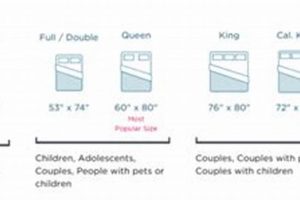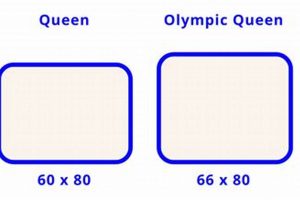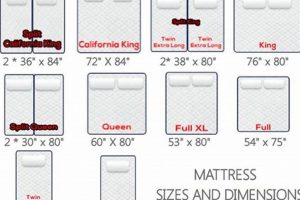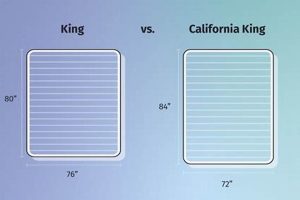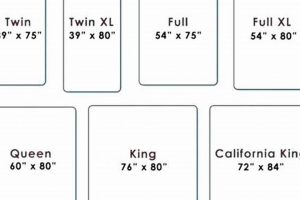The standard measurements for a full-size mattress in the United States are 54 inches in width and 75 inches in length. These figures represent the designated industry standard for what is also frequently termed a “double” bed. Understanding these specific measurements is crucial when selecting bedding, bed frames, and when planning room layouts.
Accurate knowledge of these measurements provides several benefits. It allows for informed purchasing decisions, ensuring proper fit of sheets and other bedding accessories. This standardized size also allows for easier matching with appropriate bed frames and foundations. Historically, this mattress size has served as a comfortable option for single adults or couples with limited space.
With a fundamental understanding of full-size mattress specifications, the subsequent sections will delve into topics such as: comparing the size to other mattress options, space planning considerations for bedrooms, and selecting the correct bedding.
Tips for Optimizing Your Space with a Full-Size Mattress
The following tips offer guidance on maximizing the utility and comfort of a room incorporating a full-size mattress, considering its specific dimensions.
Tip 1: Measure the Bedroom Accurately: Before acquiring a full-size mattress, meticulously measure the bedroom’s dimensions. Ensure sufficient space for comfortable movement around the bed, taking into account other furniture.
Tip 2: Consider Occupancy: A full-size mattress is often suitable for single sleepers or couples who prefer closer proximity. Evaluate sleeping habits and personal space requirements to determine if it provides adequate room.
Tip 3: Optimize Bed Frame Selection: The bed frame should accurately accommodate the industry standard measurements. A frame too large can lead to instability, while one too small can compromise support and comfort.
Tip 4: Utilize Vertical Space: In smaller rooms, employ vertical storage solutions such as shelving or tall dressers to minimize the floor space occupied by furniture. This will help balance the bed’s footprint.
Tip 5: Choose Bedding with Precision: Select sheets, comforters, and mattress protectors specifically designed for full-size mattresses. Ill-fitting bedding can detract from comfort and visual appeal.
Tip 6: Consider Room Aesthetics: Integrate the bed into the overall room design. Coordinating colors and styles of bedding, furniture, and decor creates a cohesive and inviting atmosphere.
Adhering to these recommendations will enable the optimal integration of a full-size mattress into a living space, enhancing both comfort and functionality.
Having explored specific tips, the subsequent section will address comparing full-size mattresses to other available mattress sizes.
1. Width
The designation of 54 inches for the width of a standard full-size mattress in the United States is a defining element of its overall dimensions. This precise measurement directly impacts the mattress’s suitability for different individuals and room sizes. A width deviation, even by a small margin, would disqualify a mattress from being categorized and sold as “full-size” or “double.” The standard width provides a consistent benchmark for manufacturers, retailers, and consumers.
Consider a scenario where a mattress advertised as full-size is, in reality, only 52 inches wide. This discrepancy, though seemingly minor, can lead to several practical issues. Bedding designed for a 54-inch width will not fit properly, resulting in slack and discomfort. Individuals accustomed to the typical width may find the smaller sleeping surface restrictive. Further, bed frames built to accommodate the established size will not secure the mattress effectively, potentially causing instability and premature wear.
In summary, the 54-inch width is not merely an arbitrary number; it is an integral component of the standardized full-size mattress dimensions. Deviation from this width has cascading effects on compatibility, comfort, and overall value. Understanding this connection ensures that consumers can make informed purchasing decisions and accurately assess the suitability of a full-size mattress for their specific needs.
2. Length
The specified length of 75 inches is a critical component defining a standard full-size mattress within the United States. This measurement, along with the width, determines the mattress’s overall footprint and suitability for different users and room layouts. Its adherence to this standard is vital for compatibility with bedding, frames, and overall comfort.
- Height Accommodation
The 75-inch length directly relates to the height of the individual using the mattress. Typically, this length is well-suited for individuals up to approximately 5’10” in height. Individuals taller than this may find their feet extending beyond the mattress edge, leading to discomfort and disrupted sleep. For taller individuals, a queen or king-size mattress, both offering greater length, may be a more suitable option.
- Room Layout Considerations
The 75-inch length affects space planning within a bedroom. When arranging furniture, sufficient clearance must be provided at the foot of the bed to allow for comfortable passage and prevent obstruction. This dimension, combined with the width, necessitates careful measurement of the room to ensure the mattress can be accommodated without compromising functionality. Smaller rooms might require strategic furniture placement to maximize available space.
- Bed Frame and Foundation Compatibility
A full-size bed frame and foundation are specifically designed to support a mattress that is 75 inches in length. Using a bed frame that deviates from this standard can lead to inadequate support, mattress sagging, and reduced lifespan. Precise adherence to this measurement is crucial for maintaining the integrity of the mattress and ensuring user comfort.
- Bedding Size Standards
Bedding manufacturers create sheets, comforters, and other items specifically for full-size mattresses that have a standard 75 inches in length. Using bedding that is either too short or too long can result in a poor fit, reduced comfort, and a less aesthetically pleasing appearance. Aligning bedding dimensions with this length ensures proper coverage and functionality.
In summation, the 75-inch length is an indispensable characteristic of a full-size mattress. It influences user comfort, room layout, bed frame compatibility, and bedding selection. A comprehensive understanding of this measurement allows for informed decisions when purchasing a mattress and optimizing the bedroom environment.
3. Surface Area
The surface area of a full-size mattress, derived directly from the standard dimensions, constitutes a critical factor in assessing its suitability for individual or shared occupancy. Defined by a width of 54 inches and a length of 75 inches, the resultant surface area totals 4,050 square inches. This measurable space directly correlates with sleeping comfort and the freedom of movement available to the occupant(s). A larger surface area, such as that offered by a queen or king-size mattress, generally allows for more personal space and reduced sleep disturbance, particularly for couples. Conversely, the relatively compact area of a full-size mattress may be sufficient for a single sleeper in a smaller room.
The calculation of surface area further informs choices related to bedding. Precise dimensions are essential for ensuring a proper fit for sheets, blankets, and comforters. Bedding items designed for a larger surface area will be too voluminous, potentially creating discomfort or aesthetic issues. Conversely, bedding intended for a smaller surface area will be inadequate, leaving portions of the mattress exposed. Therefore, understanding the direct relationship between the standardized dimensions and the resultant surface area is a prerequisite for selecting appropriate accessories.
In summary, the surface area is not merely a mathematical consequence of the mattress dimensions; it is a tangible factor directly influencing sleeping comfort, space planning, and the selection of compatible bedding. Neglecting to consider this relationship can lead to suboptimal sleep quality and practical inconveniences. Recognizing the significance of surface area underscores the importance of the standardized dimensions in ensuring a satisfactory mattress purchase.
4. Bed Frame Compatibility
A direct correlation exists between US full-size mattress dimensions and bed frame compatibility. The standardized dimensions of 54 inches in width and 75 inches in length dictate the internal measurements required of a corresponding bed frame. Incompatibility arising from dimensional discrepancies invariably results in compromised support, potential mattress damage, and reduced sleep quality. A bed frame designed for a queen-size mattress, for example, will inherently provide inadequate support for a full-size mattress due to the dimensional difference, causing it to shift, sag, or even fall through the frame.
The importance of bed frame compatibility extends beyond simple structural support. A properly fitted frame ensures uniform weight distribution across the mattress, prolonging its lifespan and preventing localized wear. Conversely, an ill-fitting frame concentrates pressure on specific areas, accelerating deterioration and leading to uneven support. Furthermore, the bed frame often incorporates features such as headboards and footboards, which are designed to align with the mattresss edges. Dimensional mismatches can result in unsightly gaps or overlaps, impacting the overall aesthetic appeal of the bedroom. Real-world examples include scenarios where consumers, unaware of these dimensional requirements, purchase bed frames online that, upon arrival, prove incompatible with their existing full-size mattresses, necessitating costly returns or modifications.
In conclusion, a thorough understanding of the interconnectedness between US full-size mattress dimensions and bed frame compatibility is paramount for ensuring optimal sleep comfort, mattress longevity, and structural integrity. Deviations from the standard dimensions, whether intentional or accidental, invariably lead to practical challenges that can negatively impact both the user experience and the lifespan of the mattress itself. Careful consideration of this relationship is therefore an essential prerequisite for making informed purchasing decisions and maintaining a stable and aesthetically pleasing sleep environment.
5. Room Size Adequacy
Room size adequacy, with respect to full-size mattress dimensions in the United States, is a critical factor in bedroom planning and design. The physical space a mattress occupies directly influences the functionality, aesthetics, and comfort level of the room. Accurate assessment of the available space is necessary to ensure that the introduction of a full-size mattress does not compromise usability or create an environment that feels cramped and uncomfortable.
- Clearance and Movement
Adequate room size allows for sufficient clearance around the perimeter of the bed. This clearance ensures ease of movement and prevents obstructions. Minimal clearance should be at least 24 inches, with 36 inches or more being ideal for comfortable navigation. The full-size mattress, with dimensions of 54 inches by 75 inches, requires consideration of these clearance zones. A room that is too small will result in cramped movement, potentially leading to furniture collisions and an overall sense of confinement.
- Additional Furniture
Room size adequacy must also account for additional furniture, such as dressers, nightstands, and chairs. The placement and dimensions of these items should be considered in conjunction with the mattress size. For instance, a small bedroom may only accommodate a full-size mattress and a single nightstand, whereas a larger room can comfortably house a full suite of furniture. Failure to consider this can result in an over-crowded room that is aesthetically displeasing and functionally limited.
- Visual Balance
The proportionality of the mattress size to the room’s dimensions impacts the visual balance. A full-size mattress in a very large room may appear disproportionately small, creating an imbalance. Conversely, in a very small room, a full-size mattress may dominate the space, making the room feel even smaller. Achieving visual balance requires careful consideration of the mattress size relative to the overall dimensions and proportions of the room.
- Door and Window Placement
Room size adequacy is also influenced by the placement of doors and windows. A full-size mattress should be positioned in a manner that does not obstruct access to doorways or block natural light from windows. Obstructing a doorway can impede movement and create safety hazards. Blocking a window can diminish natural light, creating a dark and uninviting atmosphere. The layout should maximize functionality and preserve the natural features of the room, considering the mattress dimensions.
In conclusion, room size adequacy, as it relates to full-size mattress dimensions, is a multifaceted consideration that encompasses movement, furniture placement, visual balance, and architectural features. Thorough assessment of these factors is crucial for creating a comfortable, functional, and aesthetically pleasing bedroom environment that appropriately accommodates the physical presence of a full-size mattress.
6. Bedding Fit
Proper bedding fit is intrinsically linked to US full size mattress dimensions, ensuring comfort, functionality, and aesthetic appeal. Deviation from standard mattress measurements compromises the fit and performance of bedding items, impacting user experience and product longevity.
- Sheet Dimensions
Fitted sheets, flat sheets, and pillowcases are manufactured according to specific dimensional standards. Fitted sheets designed for a full-size mattress, measuring 54 inches wide and 75 inches long, must accurately conform to these dimensions to ensure secure and proper coverage. Sheets that are too small will not adequately stretch over the mattress corners, resulting in slippage and discomfort. Conversely, oversized sheets will bunch and wrinkle, creating an uneven sleeping surface. The pocket depth of fitted sheets must also correspond to the mattress thickness to guarantee a snug fit. Examples include situations where standard full-size sheets fail to properly fit thicker mattresses, necessitating the purchase of deep-pocket sheets.
- Comforter/Duvet Size
Comforters and duvet inserts are designed to provide adequate coverage and warmth while also maintaining visual proportionality with the bed. A comforter designed for a full-size mattress typically extends several inches beyond the mattress edges to drape attractively and provide sufficient insulation. A comforter that is too small will leave portions of the mattress exposed, compromising warmth and aesthetic appeal. An oversized comforter, designed for a queen or king mattress, will overwhelm the bed, appearing bulky and disproportionate. The correct sizing enhances both the functional and decorative aspects of the bedding ensemble.
- Mattress Protector/Encasement Compatibility
Mattress protectors and encasements serve to shield the mattress from stains, allergens, and bed bugs. These items must fit snugly and securely to effectively perform their intended function. Oversized protectors may shift and bunch, diminishing their protective capabilities and creating discomfort. Undersized protectors may fail to fully cover the mattress, leaving vulnerable areas exposed. A properly fitted protector ensures comprehensive protection while maintaining the integrity and comfort of the mattress.
- Bed Skirt Dimensions
Bed skirts, also known as dust ruffles, serve a primarily decorative purpose, concealing the bed frame and any under-bed storage while also preventing dust accumulation. The drop length of the bed skirt, the distance from the top of the bed frame to the floor, must correspond to the height of the bed frame. A bed skirt with an insufficient drop length will expose the bed frame, undermining its intended aesthetic function. A bed skirt with an excessive drop length will pool on the floor, creating a cluttered appearance and potentially collecting dirt and debris. Accurate measurement and selection of the appropriate bed skirt dimensions are essential for achieving a visually pleasing and functional bed ensemble.
These considerations demonstrate the critical importance of adhering to standardized US full size mattress dimensions when selecting bedding. Precise measurements and compatibility are essential for ensuring optimal comfort, functionality, and aesthetic appeal within the bedroom environment. Deviation from these standards invariably leads to compromise in one or more of these key areas.
7. Occupancy Suitability
Occupancy suitability, in the context of US full size mattress dimensions, refers to the appropriateness of a mattress size for a specific number of sleepers, considering factors such as individual space requirements, sleeping habits, and comfort preferences. The dimensions of a full-size mattress directly impact its suitability for single or multiple occupants.
- Single Occupancy Comfort
A full-size mattress, with dimensions of 54 inches by 75 inches, often provides adequate space for a single sleeper. This size allows for freedom of movement during sleep and is suitable for individuals who do not require a large sleeping area. However, individuals who are taller or prefer to spread out may find the full-size mattress restrictive. Real-world examples include students in dorm rooms or adults in smaller apartments where a full-size mattress provides a balance between comfort and space efficiency.
- Double Occupancy Considerations
While a full-size mattress can accommodate two occupants, it may not provide sufficient personal space for comfortable sleep. The available width of 54 inches translates to approximately 27 inches per person, which is less than the space afforded by a twin-size mattress (38 inches). Couples who are accustomed to a queen or king-size mattress may find a full-size mattress cramped and disruptive to their sleep. However, couples who prefer close proximity or have limited space may find it an acceptable compromise. Examples include young couples sharing a small apartment or individuals who occasionally share their bed with a child.
- Sleeping Style Influence
Sleeping style significantly impacts the suitability of a full-size mattress for single or double occupancy. Individuals who are active sleepers, frequently changing positions throughout the night, require more space to avoid disturbing their sleep partner. Conversely, individuals who sleep relatively still may find a full-size mattress adequate for double occupancy. Similarly, individuals who prefer to sleep with pets may require a larger mattress to accommodate both themselves and their animal companions comfortably. These behavioral factors weigh heavily in the suitability of the bed.
- Height and Build Implications
The height and build of the occupants also play a role in occupancy suitability. Taller individuals require a longer mattress to ensure that their feet do not hang off the edge, which can lead to discomfort and disrupted sleep. Similarly, individuals with a larger build require a wider mattress to provide adequate support and freedom of movement. A full-size mattress may be less suitable for taller or larger individuals, particularly if they are sharing the bed with another person.
In summary, the occupancy suitability of a US full size mattress is contingent upon a combination of factors, including the number of sleepers, individual space requirements, sleeping habits, and physical characteristics. While a full-size mattress may be suitable for single occupancy or for couples with specific needs and preferences, it is essential to carefully consider these factors to ensure a comfortable and restful sleep experience. Considering individual comfort versus saving space will always be a key factor.
Frequently Asked Questions Regarding US Full Size Mattress Dimensions
This section addresses common inquiries concerning the standard measurements of full-size mattresses in the United States. The information aims to provide clarity and assist in informed decision-making.
Question 1: What are the precise dimensions of a US full-size mattress?
The standard measurements for a full-size mattress in the United States are 54 inches in width and 75 inches in length. These figures represent the industry-recognized standard. Any deviation from these measurements would classify the mattress outside of the full-size category.
Question 2: Why are standardized dimensions important?
Standardized dimensions ensure compatibility with bed frames, bedding, and other accessories. These dimensions allow for a consistent fit, promoting stability and aesthetic appeal.
Question 3: Are there variations in full-size mattress dimensions among different manufacturers?
While minor manufacturing tolerances may exist, reputable manufacturers adhere closely to the 54-inch by 75-inch standard. Significant deviations should be cause for concern and warrant verification.
Question 4: How do full-size dimensions compare to those of a twin-size mattress?
A twin-size mattress measures approximately 38 inches wide and 75 inches long. Therefore, a full-size mattress offers an additional 16 inches of width compared to a twin.
Question 5: Is a full-size mattress suitable for two adults?
While a full-size mattress can accommodate two adults, the limited width (27 inches per person) may result in a cramped sleeping experience. A larger mattress, such as a queen or king, is generally recommended for couples.
Question 6: What size room is recommended for a full-size mattress?
A room size of at least 10 feet by 10 feet is recommended to comfortably accommodate a full-size mattress and other essential furniture, allowing adequate space for movement.
This FAQ section offers a concise overview of key aspects related to the dimensions. Understanding these points enables more informed decisions regarding mattress selection.
The subsequent section will transition into considerations of price and value when purchasing mattresses.
Us Full Size Mattress Dimensions
This examination has systematically detailed the significance of the standardized measurements for full-size mattresses in the United States. The established dimensions of 54 inches in width and 75 inches in length are not arbitrary, but rather foundational to ensuring compatibility with bedding, bed frames, and appropriate room sizes. Further, these dimensions directly impact individual comfort, particularly in the context of single versus double occupancy.
A clear understanding of these specifications is crucial for making informed purchasing decisions. Inaccurate or misleading representations of dimensions can lead to practical inconveniences and compromised sleep quality. Therefore, due diligence is paramount in confirming the adherence to the industry standard. Prospective buyers are encouraged to rigorously verify the dimensions prior to purchase, thereby ensuring long-term satisfaction and optimal value.



